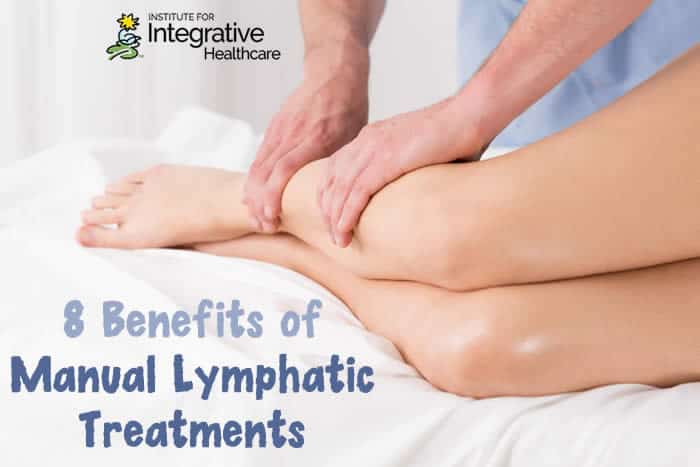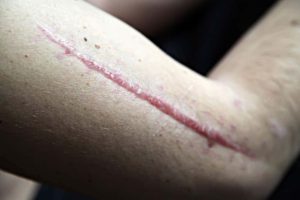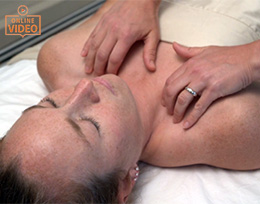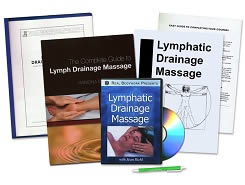

Distinction Between Different Types of Lymphatic Approaches
Manual therapies promoting lymphatic flow movement vary nationwide. A general distinction can be made between the terms “lymphatic drainage” versus “lymphatic massage.”
- Typically, lymphatic drainage involves techniques akin to the Vodder method, which encourages a pulling and stretching the skin to encourage lymph fluid to move through the superficial lymph vessels.
- Lymphatic massage typically involves light sweeping effleurage strokes to encourage superficial lymph vessel movement. The intention of this brand of massage is to focus upon enhancing lymphatic fluid flow with little emphasis on muscles.
When a client requests a lymphatic treatment, it is prudent to ask the client of their expectation of manual lymphatic treatments to avoid confusion and meet client expectations. If a client has received manual lymphatic drainage in a hospital setting, there is a good possibility this person has received Vodder or similar style of work, which looks and feels very different from a typical massage.
Complete Decongestive Therapy (CDT)
After obtaining initial training, a therapist specializing in lymphatic drainage and/or lymphatic massage may choose to take advanced training to learn Complete Decongestive Therapy (CDT). This involves in-depth training on compression bandaging and equipment use to further aid manual lymphatic therapists to aid clients with advanced stages of lymphedema.
This advanced training is available at the following organizations:
- Klose Training Lymphedema Certification
- Academy of Lymphatic Studies
- Norton School of Lymphatic Therapy
- Brennan School of Innovative Lymphatic Studies
History of Lymphatic Treatments
Manual lymphatic treatments as understood today have their roots in the early 20th century. Frederick Millard first popularized the phrase “lymphatic drainage” in 1925 within modern medicine utilizing manual techniques to encourage lymphatic flow through the body.
A decade later, Dr. Emil Vodder and his wife, Estrid, devised the Vodder method of lymphatic drainage, which received recognition from the medical community for effectively treating chronically ill patients.
Dr. Bruno Chickly began presenting and expanding upon his predecessors with lymphatic treatments in the United States beginning in the 1980s. He helped develop protocols and programs to effectively treat lymphedema patients.
Today, there are several programs offering formal manual lymphatic training to aid chronically ill patients of many sorts, including cancer and HIV patients. (1)
Clients Report These 8 Benefits After Receiving Manual Lymphatic Treatments

There are many benefits reported by clients receiving manual lymphatic treatments.
- The appearance of both old and new scars can be reduced. Treatments may be performed before and after a cosmetic surgery.
- Fend off skin conditions such as acne and rosacea to keep skin clear.
- Support postpartum care to aid new mothers’ healing and reduction of edema. Breastfeeding can be enhanced, especially when women experience breast soreness or blocked mammary ducts.
- Aid in detoxification efforts to support organ health and exercise regimens.
- Expedite healing post-surgery aiding in metabolic waste removal and reduced inflammation.
- Reducing sinus and similar headaches caused by congestion within the cranial sinuses.
- Relief of postmenstrual syndrome (PMS) symptoms and mood modulation.
- Improved relaxation, as manual lymphatic treatments are gentle and soothing. (2)
Contraindications
There are contraindications to consider before a patient receives lymphatic drainage or massage efforts. Some of these are absolute, meaning any manual efforts should be avoided, while others are relative, meaning cautions should be considered to modify current manual treatment efforts.
6 Absolute Contraindications
- Acute inflammation, which is described as redness, heat and swelling witnessed within the first week of injury or disease onset. Lymphatic efforts may expedite chemical processes too quickly during the acute stage of repair and disease control.
- Acute phlebitis, which is inflammation of veins. Lymphatic efforts will exacerbate this inflammation and tax the vascular system when performed too soon.
- Malignant tumors, whose cells are unstable or recurring with metastasizing cells. Lymphatic efforts may enhance inflammatory responses and edema present in affected areas.
- Acute thrombosis, the formation of clots may become an embolus (mobile mass within blood vessel). Lymphatic efforts may break clots free. Most common areas for these clots (emboli) to travel will be the lungs and brain.
- Congestive heart problems, which is the heart weakening in a progressive fashion. Pumping more lymphatic fluid will impact the cardiovascular system, which can tax the heart in a weakened or frail client.
- Chemotherapy, as the expected increase in white blood cell count counters the intended goal of chemotherapy, which is to eradicate cells.
8 Relative Contraindications

- First trimester of pregnancy if there are medical complications occurring, maternal history of miscarriage or pregnancy is considered “high risk” as defined by American Medical Association standards.
- Thyroid dysfunction, as either hyperfunction or hypofunction will create metabolic challenges and alter how lymphatic system may operate.
- Autoimmune disease patients may experience flare-ups during the course of lymphatic treatments if their white blood cell count increases greatly.
- Kidney disease, making elimination efforts more physically demanding.
- Medications such as cortisone and prednisone, which cause water retention.
- Autoimmune disease during the waxing stage (flare-ups). Wait until the waning stage to support tissue healing and detoxification.
- Hyper or hypotension, as the heart may work harder due to lymphatic treatments in some individuals.
- Diabetes, as the immune system may act irregular after lymphatic treatments in some individuals. (3)
Can Lymphatic Treatment Approaches Spread Cancer?
One common concern many health professionals used to hold was the belief that massage or manual efforts to increase circulation of blood and lymph would spread cancer cells.
Addressing this concern, Dr. Ann LaCasce of the Dana Farber CancerCare Fellowship Program in Hematology & Medical Oncology states: “There is absolutely no evidence that lymphoma can be spread by massage. We do not think of lymphoma as a disease that metastasizes—rather, it is often a systemic disease that travels through the lymphatics and blood, and can land in any area of the body. Furthermore, manipulating tissue does not cause tumor cells to move.” (4)
Metabolic mechanisms within cancer cells are considered a greater determinant in the growth and progression of cancer as opposed to external forces. These internal cellular mechanisms are studied by oncologists today while drugs are created to combat these internal drivers of cancer progression. Immunotherapies and complementary treatments, of which lymphatic movement efforts may be included, are primary means towards combating cancer without the risk of spreading malignant cells through the body. (5)
Recommendations for Treatment Frequency
Various health professionals indicate that the frequency of manual lymphatic treatments depends primarily upon the physical health of the patient.
Here is a general rule I present in lymphatic classes:
- For patients who are recovering swiftly from ailment with no complications, 1—2 sessions (60 minutes) weekly will be beneficial.
- For patients recovering slowly and/or experiencing complications such as blood challenges, stressed immune system, liver dysfunction, or the kidneys, spleen or lungs are not functioning well, only 1—2 sessions (60 minutes) monthly will suffice.
The primary goals of a manual lymphatic treatment are to expedite waste removal and enhance immune responses. While achieving these goals, a client may experience cold and flu like symptoms, which is important for the practitioner to inform the client. After these symptoms dissipate, clients will experience a refreshing restoration of health, vigor and vitality.













